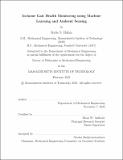In-home Gait Health Monitoring using Machine Learning and Ambient Sensing
Author(s)
Hahm, Katie S.
DownloadThesis PDF (10.38Mb)
Advisor
Anthony, Brian W.
Terms of use
Metadata
Show full item recordAbstract
Gait health assessments are commonly used for clinical evaluations of neurocognitive diseases and general well-being. Gait parameters such as step time variability and ground reaction forces are essential in distinguishing pathological and normal gait; changes in gait can be observed years before a patient is diagnosed with diseases such as Parkinson’s disease. Despite its importance, the current standard of practice for gait assessments is performed in clinical settings. These measurements are often elevated and do not accurately reflect gait patterns in daily life. There is a need for gait monitoring in the daily environmental setting.
Internet-of-Things technology creates an opportunity to bridge this disparity in gait measurements by bringing sensors into the home environment. An ambient floor sensing approach is presented which uses the vibrations in the floor naturally created by footfalls to monitor gait. A few accelerometers are used to measure these signals, lowering the sensor density for easier deployability while minimizing privacy concerns.
This thesis is comprised of four parts. First, signal processing algorithms are developed to extract relevant features from the floor vibrations. Second, temporal gait asymmetry is estimated using an adapted gaussian mixture model approach. Third, the footfalls are localized through a tracking machine learning approach. Lastly, the tibial acceleration is estimated using machine learning. Experiments were performed to evaluate the performance of these estimations for single person and two people walking scenarios.
Date issued
2023-02Department
Massachusetts Institute of Technology. Department of Mechanical EngineeringPublisher
Massachusetts Institute of Technology